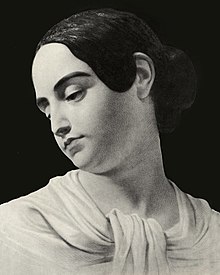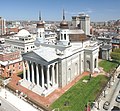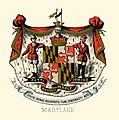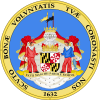Portal:Maryland
|
Maryland Portal
|
Baltimore Task Force
|
Frederick Task Force
|
Montgomery Task Force
|
WikiProject Maryland
|
|
Main page
|
Discussion
|
Introduction Maryland (US: /ˈmɛrɪlənd/ ⓘ MERR-il-ənd) is a state in the Mid-Atlantic region of the United States. The state borders Virginia to its south, West Virginia to its west, Pennsylvania to its north, Delaware to its east, the Atlantic Ocean, and the national capital of Washington, D.C. With a total area of 12,407 square miles (32,130 km2), Maryland is the ninth-smallest state by land area, and its population of 6,177,224 ranks it the 18th-most populous state and the fifth-most densely populated. Maryland's capital is Annapolis, and the most populous city is Baltimore. Occasional nicknames include Old Line State, the Free State, and the Chesapeake Bay State. It is named after Henrietta Maria, the French-born queen of England, Scotland, and Ireland during the 17th century. Maryland's coastline was first explored by Europeans in the 16th century. Prior to that, it was inhabited by several Native American tribes, mostly the Algonquian peoples and, to a lesser degree, Iroquoians and Siouans. As one of the original Thirteen Colonies, Maryland was founded by George Calvert, 1st Baron Baltimore, a Catholic convert who sought to provide a religious haven for Catholics persecuted in England. In 1632, Charles I of England granted Lord Baltimore a colonial charter, naming the colony after his wife, Henrietta Maria. Unlike the Pilgrims and Puritans, Lord Baltimore envisioned a colony where people of different religious sects would coexist under the principle of toleration. In 1649, the Maryland General Assembly passed an Act Concerning Religion, which enshrined this principle by penalizing anyone who "reproached" a fellow Marylander based on religious affiliation. Nevertheless, religious strife was common in the early years, and Catholics remained a minority, albeit in greater numbers than in any other English colony. Maryland's early settlements and population centers clustered around rivers and other waterways that empty into the Chesapeake Bay. Its economy was heavily plantation-based and centered mostly on the cultivation of tobacco. Demand for cheap labor from Maryland colonists led to the importation of numerous indentured servants and enslaved Africans. In 1760, Maryland's current boundaries took form following the settlement of a long-running border dispute with Pennsylvania. Maryland was an active participant in the events leading up to the American Revolution, and by 1776, its delegates signed the Declaration of Independence. Many of its citizens subsequently played key political and military roles in the war. Although then a slave state, Maryland remained in the Union during the American Civil War, its strategic location giving it a significant role in the conflict. After the Civil War, Maryland took part in the Industrial Revolution, driven by its seaports, railroad networks, and mass immigration from Europe. Since the 1940s, the state's population has grown rapidly, to approximately six million residents, and it is among the most densely populated U.S. states. , Maryland had the highest median household income of any state, owing in large part to its proximity to Washington, D.C., and a highly diversified economy spanning manufacturing, retail services, public administration, real estate, higher education, information technology, defense contracting, health care, and biotechnology. Maryland is one of the most multicultural states in the country; it is one of the six states where non-Whites compose a majority of the population, with the fifth-highest percentage of African Americans, and high numbers of residents born in Africa, Asia, Central America, and the Caribbean. The state's central role in U.S. history is reflected by its hosting of some of the highest numbers of historic landmarks per capita. (Full article...) This is a Featured article, which represents some of the best content on English Wikipedia..
Virginia Eliza Poe (née Clemm; August 15, 1822 – January 30, 1847) was the wife of American writer Edgar Allan Poe. The couple were first cousins and publicly married when Virginia Clemm was 13 and Poe was 27. Biographers disagree as to the nature of the couple's relationship. Though their marriage was loving, some biographers suggest they viewed one another more like a brother and sister. In January 1842, she contracted tuberculosis, growing worse for five years until she died of the disease at the age of 24 in the family's cottage, at that time outside New York City. Along with other family members, Virginia Clemm and Edgar Allan Poe lived together off and on for several years before their marriage. The couple often moved to accommodate Poe's employment, living intermittently in Baltimore, Philadelphia, and New York. A few years after their wedding, Poe was involved in a substantial scandal involving Frances Sargent Osgood and Elizabeth F. Ellet. Rumors about amorous improprieties on her husband's part affected Virginia Poe so much that on her deathbed she claimed that Ellet had murdered her. After her death, her body was eventually placed under the same memorial marker as her husband's in Westminster Hall and Burying Ground in Baltimore, Maryland. Only one image of Virginia Eliza Clemm Poe has been authenticated: a watercolor portrait painted several hours after her death. (Full article...)General imagesIn the news
On this day...This is a Good article, an article that meets a core set of high editorial standards.
 The Maryland Senate, sometimes referred to as the Maryland State Senate, is the upper house of the General Assembly, the state legislature of the U.S. state of Maryland. Composed of 47 senators elected from an equal number of constituent single-member districts, the Senate is responsible, along with the Maryland House of Delegates, for passage of laws in Maryland, and for confirming executive appointments made by the Governor of Maryland. It evolved from the upper house of the colonial assembly created in 1650 when Maryland was a proprietary colony controlled by Cecilius Calvert. It consisted of the Governor and members of the Governor's appointed council. With slight variation, the body to meet in that form until 1776, when Maryland, now a state independent of British rule, passed a new constitution that created an electoral college to appoint members of the Senate. This electoral college was abolished in 1838 and members began to be directly elected from each county and Baltimore City. In 1972, because of a Supreme Court decision, the number of districts was increased to 47, and the districts were balanced by population rather than being geographically determined. (Full article...)Selected article - Steny Hamilton Hoyer (/ˈstɛni ˈhɔɪər/ STEN-ee HOY-ər; born June 14, 1939) is an American politician and retired attorney who has served as the U.S. representative for Maryland's 5th congressional district since 1981. He also served as House Majority Leader from 2007 to 2011 and again from 2019 to 2023. Hoyer first attained office through a special election on May 19, 1981. As of 2023, he is in his 22nd House term. His district includes a large swath of rural and suburban territory southeast of Washington, D.C. Hoyer is the dean of the Maryland congressional delegation and the most senior Democrat in the House. From 2003 to 2023, Hoyer was the second-ranking Democrat in the House of Representatives behind Nancy Pelosi. He is a two-time House majority leader, having served in the post from 2007 to 2011 under Speaker Pelosi. During two periods of Republican House control (2003–2007 and 2011–2019), Hoyer served as House minority whip, both times under Minority Leader Pelosi. Following the 2018 midterm elections in which the Democrats took control of the House, Hoyer was reelected majority leader in 2019 for the 116th Congress; he remained the number two House Democrat behind Speaker Pelosi. He announced on November 17, 2022, that he, along with Pelosi, would not seek a leadership position in the 118th Congress, though he would remain a member of the House. (Full article...)Did you know?

SubcategoriesSelect [+] to view subcategories
TopicsRelated portalsAssociated WikimediaThe following Wikimedia Foundation sister projects provide more on this subject:
Discover Wikipedia using portals |























































